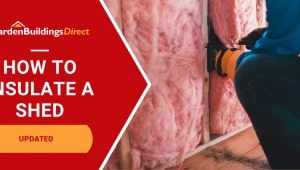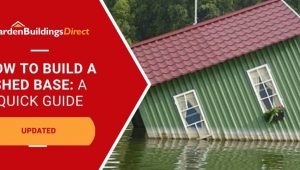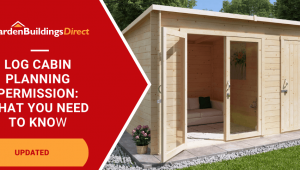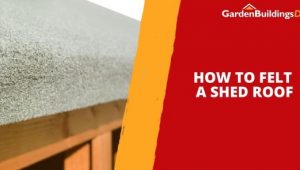Jump to:
No project goes well without preparation, and that includes having the tools to build a log cabin for the garden. Each tool in this list plays a role in making the cabin come together, when using a prefab self-assembly log cabin kit. Here’s what you need.
Go through this list before you begin, and you’ll keep the project on track from start to finish. Good luck!
Note that this is for garden room cabins, not log homes.
The Quick Checklist of Tools to Build a Log Cabin
Essentials:
- Phillips screwdriver (small and large sizes, e.g., No. 1 and No. 2 and/or No. 3)
- Hammer or mallet
- Tape measure (8 to 10 metres, wide blade, optional magnetic hook/claw)
- Carpenter’s pencil (flat with thick lead, plus spares and a sharpener)
- Spirit level (aluminium body, at least 1 metre, optional smaller level and laser level)
- Handsaw (for adjustments)
Power tools:
- Drill (cordless or corded, with extra batteries if cordless)
- Drill bits (wood bits in various sizes, HSS or titanium-coated)
- Utility knife (heavy-duty handle, ~18 mm snap-off blades, locking blade)
Extras:
- Silicone gun and exterior-rated silicone (clear or natural recommended)
- Step ladder (6–8 ft or 8–10 ft, folding aluminium or heavier for stability)
Log Cabin Tools, Explained
Here’s what role each tool plays in your garden log cabin project:
Phillips screwdriver
You’ll want a quality screwdriver that drives screws straight and makes the build strong. Keep at least two sizes ready: one for smaller screws (e.g., No. 1) and another for larger fittings (e.g., No. 2 to No. 3). They cover nearly all the fittings you’ll encounter in a self-assembly log cabin.
Hammer or mallet
Both are useful during the build. A hammer drives nails with force, while a mallet nudges logs without overstriking. Reach for the mallet to adjust positions, and the hammer for firmer fixes. Make sure it’s a rubber mallet to avoid denting the wood.
Tape measure
Pick one that’s at least 8 to 10 metres long, since shorter tapes won’t cover the span of larger logs. A wider blade, around 25 mm, holds straight when extended, which makes it easier to measure long pieces.
A magnetic hook or claw is worth having, too; it grips logs or beams and keeps solo measuring steady.
Pencil
Go for a carpenter’s pencil that is flat and has a thicker lead. Have a few spares in your kit and a sharpener made for this type. Feel free to stash a marker pen for darker or damp wood where pencil marks don’t stand out.
Level
A sturdy spirit level with an aluminium body won’t warp the way plastic ones can. Aim for a length of at least a metre so it reaches across wider logs. Carry a smaller level in your belt, and add a laser level if you want faster alignment across whole walls.
Utility knife
Don’t skimp here. Go for a knife with a heavy-duty handle that won’t flex, and blades at approximately 18 mm wide. Snap-off blades are best, giving you a sharp edge whenever you need one. And with a locking blade, you won’t have it shifting mid-cut. The knife helps you trim the roof felt.
Drill
For a cabin project, go with a drill that won’t quit halfway. We recommend a cordless drill that allows you to move around freely. Be sure to have extra batteries so you’re not left waiting for a charge.
A corded drill is also solid, especially if you have power nearby and expect long sessions.
Drill bits
A set of wood bits in different sizes is a must. Invest in high-speed steel (HSS) bits or titanium-coated ones – they last longer on dense timber. You’ll be switching between sizes a lot, so keep your bits in a case and replace any that start to dull.
Wood saw
Wooden parts don’t always come perfect, and sometimes you’ll need to trim them to fit between other parts. This usually applies to the floorboards and some of the parts around the roof. If you have an electric spinning saw, this can help speed up the process of trimming lengthways if that becomes necessary.
Extra Log Cabin Building Tools
There are a few more tools on the list: one for finishing, and another that’s optional:
Silicone gun and silicone
Silicone helps to seal the small gaps in your cabin after assembly. This is best applied after the first coat of treatment. Use it on the corner trims, window and door frames, and on any external gaps.
A silicone gun that holds standard 300ml cartridges is a good choice. For the silicone itself, pick one rated for exterior use with good adhesion to timber. One example is a clear or natural silicone, which is best for log seams, as it blends in and makes touch-ups easier.
Step ladder
This is essential if parts of your cabin are out of reach—a 6 to 8 ft or 8 to 10 ft ladder is standard. A folding aluminium ladder will suffice; it’s not too heavy and is easy to reposition as needed.
Sandpaper/electric sander
Reduce splinters by smoothing down the wood after assembly. This can also help prepare it for painting.
Safety Gear for Building a Log Cabin
It’s better to have these items and not need them, than to need them and not have them.
Gloves
Working with wood inevitably involves splinters. Cover those hands.
Safety glasses
Whether it’s flying splinters or a dropped nail above your head, keep your eyes safe from small, sharp objects.
If you’re all set, read this guide next: How To Build A Log Cabin





